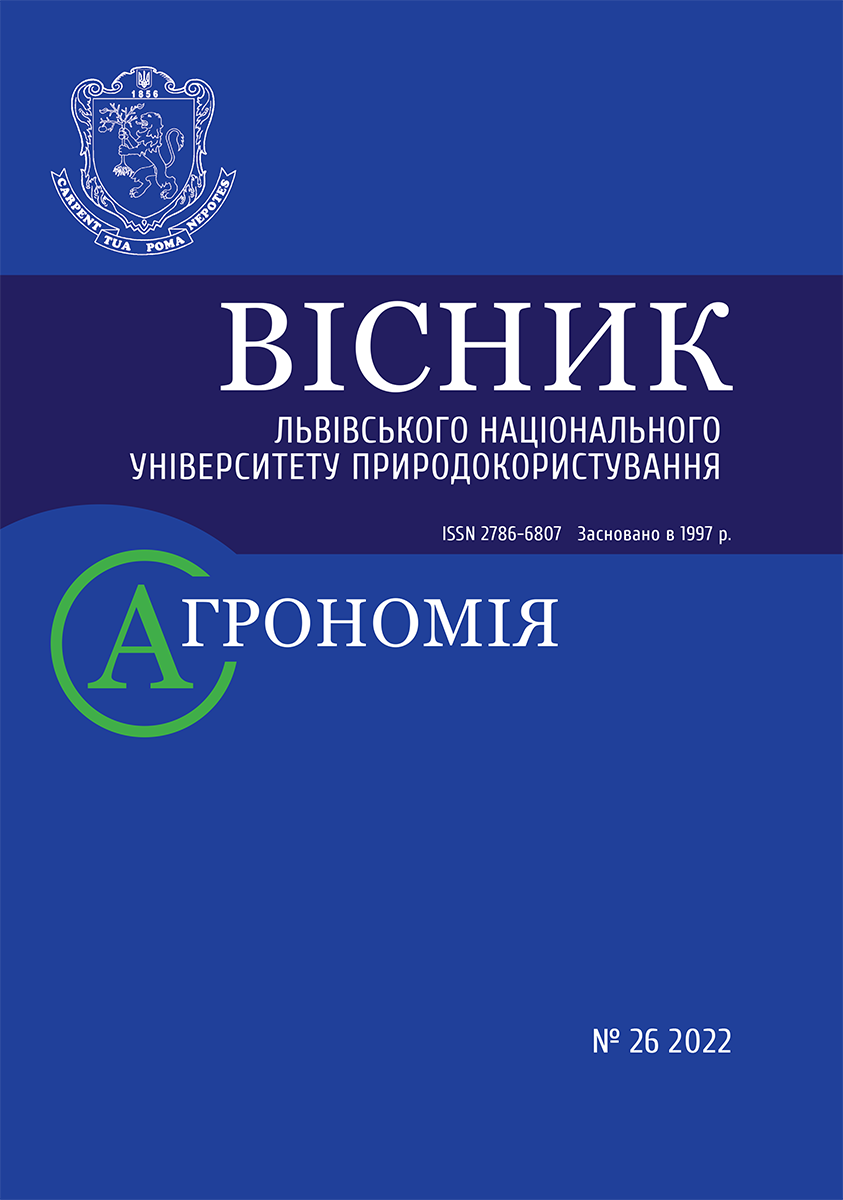INCREASING CROP YIELD BY MYCORRHIZATION OF THE ROOT SYSTEM
DOI:
https://doi.org/10.31734/agronomy2022.26.142Keywords:
productivity, mycorrhization, fungi, winter wheat, corn, sunflower, soybeanAbstract
The purpose of the research was to reveal the effect of mycorrhization of the root system of crops on their yield. Based on the results of research carried out in the years 2017–2021, it was found that mycorrhization of the root system of crops contributes to a significant increase in the yield of soft winter wheat, corn (Zea mays), sunflower, and soybean. Pre-seeding treatment was carried out in the shade (to avoid direct sunlight) by spraying with (or soaking in for two hours) a working solution on the day of sowing. Seed treatment was performed by manual using a sprayer. In particular, when using mycorrhizal fungi Tuber melanosporum Vittad. (bio preparation Mycovital), Trichoderma harzianum Rifai. (bio preparation Mycofriend), and bacteria Bacillus subtilis Cohn. (bio preparation Florobacillin) for pre-sowing seed treatment, the grain yield of soft winter wheat increased by 7.4–22.3 % as compared to the control. The yield of corn, sunflower, and soybean was also significantly higher than in the control. Thus, the yield of grain in all experimental treatments was higher as compared to control, specifically by 19.3–39.4 % in corn, by 24.4–43.5 % in sunflower, and by 16.4–37.7 % in soybean. The positive effect of Mycofriend (Trichoderma harzianum Rifai.) on the yield of all the studied crops was especially noticeable, with a yield increase of 22.3–43.5 %. In the treatments with other bio preparations (Mycovital and Florobacillin), the yield of the studied crops was slightly lower than in treatments with Mycofriend. Nevertheless, the yield increase was enough convincing. To conclude, the use of mycorrhizal fungi and nitrogen-fixing bacteria contributes to a significant increase in the yield of crops.
References
Appropriate nonmycorrhizal controls in arbuscular mycorrhiza research: a microbiome perspective / Gryndler M., Šmilauer P., Püschel D. et al. Mycorrhiza. 2018. No 28 (5). P. 435–450.
Ecological physiology of plants: textbook / V. H. Skliar; in general ed. Yu. A. Zlobina. Sumy: University Book, 2015. 271 p.
Effectiveness of agrocenoses of leguminous crops / Dydovych S. V., Zotov V. S., Turina E. L. et al. Collection of scientific works SWorld. 2015. Issue 1 38. Vol. 24. P. 22–25.
Holovina A. O. Balanced use of soil resources and management of reproduction of soil fertility. Can we change? 2018. No 9. P. 117.
Kaminskyi V. F., Hanhur V. V. Dynamics of soil moisture productivity during winter wheat cultivation in crop rotations of the Left Bank Forest Steppe of Ukraine. Bulletin of the Poltava State Agrarian Academy. 2018. No 3. P. 11–14.
Kolesnichenko O. V. Anatomical and morphological structure of leaves of Castanea sativa Mill. as a factor in stabilizing the water regime of plants in drought conditions. Scientific reports of the National University of Bioresources and Nature Management of Ukraine. 2015. No 5. Available at: http://nbuv.gov.ua/UJRN/Nd_2015_5_31.
Kovalevskyi S. B., Kryvohatko H. A. Drought resistance and water-holding capacity of THUJA OCCIDENTALIS L. plants and its cultivars. Scientific bulletin of NLTU of Ukraine. 2018. Vol. 28, No 2. P. 77–80.
Mamenko T. P., Yaroshenko E. A., Yakymchuk R. A. Water status and productivity of winter wheat under the influence of drought and salicylic acid. Physiology and biochemistry cult. plants. 2009. No 5, Vol. 41. P. 447–453.
Myshke I. V. Microbial phytohormones in plant breeding. Riga: Zinatne, 1988. 151 p.
Oliferchuk V. P., Fedorovych V. Influence of the mycorrhizal fungus Tuber Melanosporum on the biodiversity of rhizosphere micromycetes and the growth and productivity of hazelnuts. Scientific bulletin of NLTU of Ukraine. 2021, No 31.2. P. 28–34.
Prysiazhniuk O. I., Korovko I. I. Dynamics of chlorophyll content in sugar beet leaves. New agricultural technologies. 2015. No 3. P. 11–12.
Rozumova S. G. Ecology of plants with the basics of botany and physiology: Lecture notes. Odesa, 2013. 119 p.
Romanenko S. M. Actual issues of ensuring environmental safety of agricultural products and exercising the laws on organic production and food security: mater. science and practice con. (Itomir, April 23, 2015). Itomyr: Olissya, 2015. P. 186–194.
Smith S. E. Mycorrhizal symbiosis. Read; [3nd eds.]. London: Academic Press, 2008. 815 p.
Volkohon V. V., Nadkernychna O. V., Kavalevska T. M. and others. Microbial preparations in agriculture. Theory and practice: monograph. Under the editorship V. V. Volkohon. Kyiv: Agrarian Science, 2006. 312 p.


